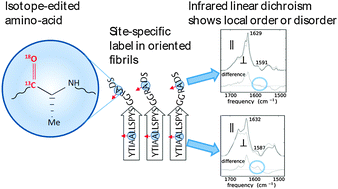Local orientational disorder in peptide fibrils probed by a combination of residue-specific 13C–18O labelling, polarised infrared spectroscopy and molecular combing†
Abstract
A novel combination of site-specific isotope

* Corresponding authors
a
Department of Chemistry, University of Reading, Whiteknights Campus, Reading RG6 6AD, UK
E-mail:
a.m.squires@reading.ac.uk
Tel: +44 118 378 4736
b Department of Chemical and Biomolecular Engineering and Bio21 Molecular Science and Biotechnology Institute, The University of Melbourne, Parkville, Victoria 3010, Australia
A novel combination of site-specific isotope

 Please wait while we load your content...
Something went wrong. Try again?
Please wait while we load your content...
Something went wrong. Try again?
J. C. Rodríguez-Pérez, I. W. Hamley, S. L. Gras and A. M. Squires, Chem. Commun., 2012, 48, 11835 DOI: 10.1039/C2CC35586H
To request permission to reproduce material from this article, please go to the Copyright Clearance Center request page.
If you are an author contributing to an RSC publication, you do not need to request permission provided correct acknowledgement is given.
If you are the author of this article, you do not need to request permission to reproduce figures and diagrams provided correct acknowledgement is given. If you want to reproduce the whole article in a third-party publication (excluding your thesis/dissertation for which permission is not required) please go to the Copyright Clearance Center request page.
Read more about how to correctly acknowledge RSC content.
 Fetching data from CrossRef.
Fetching data from CrossRef.
This may take some time to load.
Loading related content
